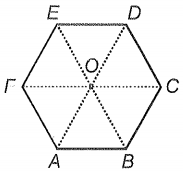If two force vectors of the same magnitude are arranged in the following manner, the magnitude of resultant is maximum for?

(1) (I)
(2) (II)
(3) Both (II) & (III)
(4) Both (I) & (II)

The minimum number of non-coplanar vectors whose vector sum can be zero is:
(1) 2
(2) 3
(3) 4
(4) 5
The resultant vector of makes angle with and with .Then-
1.
2.
3.
4.
The figure shows ABCDEF as a regular hexagon. What is the value of ?

1.
2.
3.
4.
A vector , which has magnitude 8.0 is added to a vector which lies on the x-axis. The sum of these two vectors lies on the y-axis and has a magnitude twice the magnitude of . The magnitude of the vector
1. 8
2.
3.
4.
If and , then the unit vector in the direction of is
1.
2.
3.
4.
The forces are acting perpendicular to each other at a point and have resultant R. If force is replaced by acting in the direction opposite to that of , the magnitude of resultant
(1) Becomes half
(2) Becomes double
(3) Becomes one third
(4) Remains the same
A force of \(20\) N acts on a particle along a direction, making an angle of \(60^\circ\) with the vertical. The component of the force along the vertical direction will be:
| 1. | \(2\) N | 2. | \(5\) N |
| 3. | \(10\) N | 4. | \(20\) N |
If \(\overrightarrow {A}\) \(\overrightarrow{B}\) are two vectors inclined to each other at an angle \(\theta,\) then the component of \(\overrightarrow {A}\) perpendicular to \(\overrightarrow {B}\) and lying in the plane containing \(\overrightarrow {A}\) and \(\overrightarrow {B}\) will be:
1. \(\frac{\overrightarrow {A} \overrightarrow{.B}}{B^{2}} \overrightarrow{B}\)
2. \(\overrightarrow{A} - \frac{\overrightarrow{A} \overrightarrow{.B}}{B^{2}} \overrightarrow{B}\)
3. \(\overrightarrow{A} -\overrightarrow{B}\)
4. \(\overrightarrow{A} + \overrightarrow{B}\)
If \(\left|\overrightarrow A\right|\ne \left|\overrightarrow B\right|\) and \(\left|\overrightarrow A \times \overrightarrow B\right|= \left|\overrightarrow A\cdot \overrightarrow B\right|\), then:
| 1. | \(\overrightarrow A \perp \overrightarrow B\) |
| 2. | \(\overrightarrow A ~|| ~\overrightarrow B\) |
| 3. | \(\overrightarrow A\) is antiparallel to \(\overrightarrow B\) |
| 4. | \(\overrightarrow A\) is inclined to \(\overrightarrow B\) at an angle of \(45^{\circ}\) |






